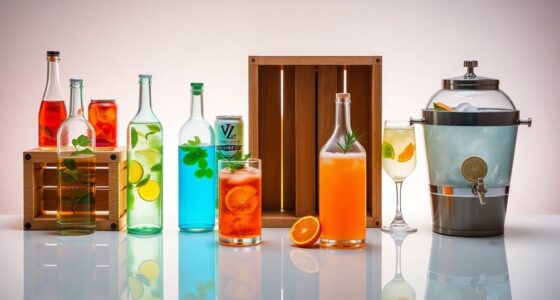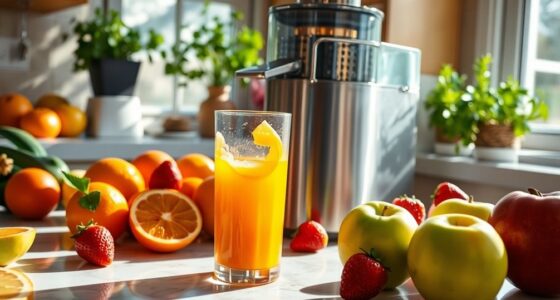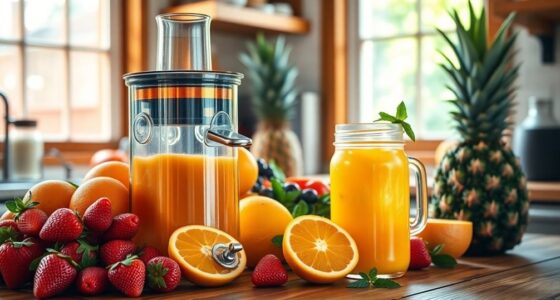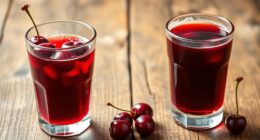To opt for eco-friendly juice packaging and storage, choose drinks in glass or aluminum containers, which are highly recyclable. Avoid single-use plastics that harm the environment and your health. Consider buying juice in bulk or making your own at home to minimize waste. Look for brands using biodegradable materials and supporting local producers to cut down on transportation emissions. Want to learn more about sustainable juice practices and how they can benefit you?
Key Takeaways
- Choose juices packaged in glass or aluminum containers to support recycling and reduce reliance on single-use plastics.
- Look for brands that utilize biodegradable packaging made from renewable resources to minimize environmental impact.
- Invest in reusable glass or stainless steel containers for juice storage to maintain freshness and reduce waste.
- Buy juice in bulk from local sources to decrease packaging waste and lower transportation emissions.
- Educate yourself on proper recycling practices for juice containers to ensure they are disposed of responsibly.
Understanding Eco-Friendly Juice Packaging
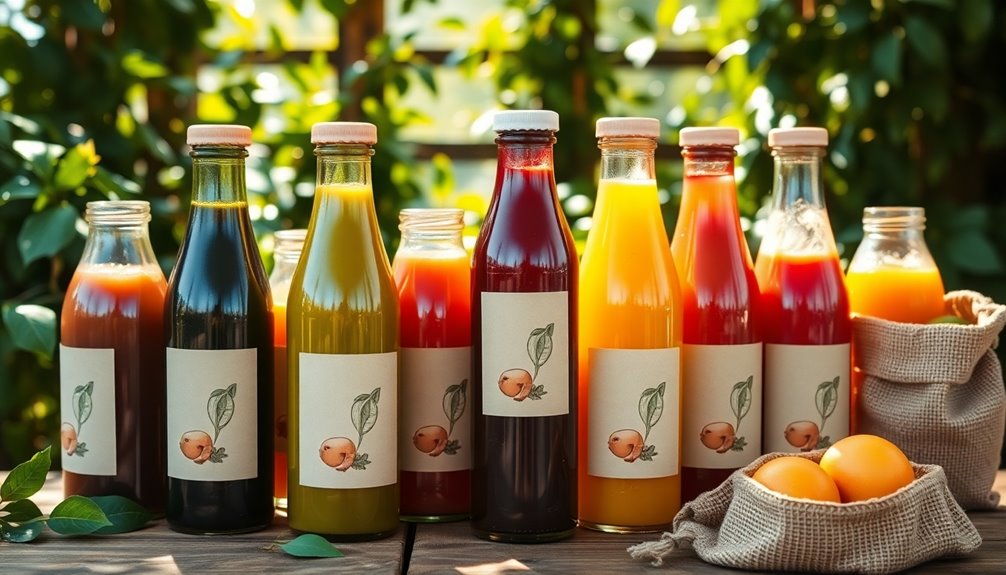
As you explore eco-friendly juice packaging, you'll find that it plays an essential role in reducing environmental impact.
Sustainable packaging options, like glass, aluminum, and biodegradable plant-based plastics, are designed to minimize plastic waste. These materials are recyclable and derived from renewable resources, such as cornstarch and sugarcane, helping to combat the issues associated with single-use plastics.
Innovations, like aseptic technology, extend juice shelf life without refrigeration, cutting down on energy consumption. The extraction process plays a crucial role in ensuring that the juice retains its freshness and quality during packaging.
While flexible packaging can have its challenges, it often requires less material and energy during production and transportation, making it a viable eco-friendly option when designed for recyclability.
The Environmental Impact of Single-Use Plastics

While you might enjoy the convenience of single-use plastics, their environmental impact is alarming. In the juice industry, these products contribute to a growing crisis. Consider these facts:
- Millions of tons of plastic bottles, caps, and straws are discarded each year.
- Single-use plastics take centuries to decompose, causing severe pollution.
- Their production emits considerable greenhouse gas emissions, exacerbating climate change.
- Littered plastics harm wildlife and ecosystems, disrupting natural habitats.
With the urgent need for sustainable alternatives, adopting eco-friendly practices in packaging can notably reduce packaging waste. Additionally, transitioning to renewable energy sources for production can further decrease the overall carbon footprint associated with packaging materials.
Health Risks Associated With Plastic Packaging
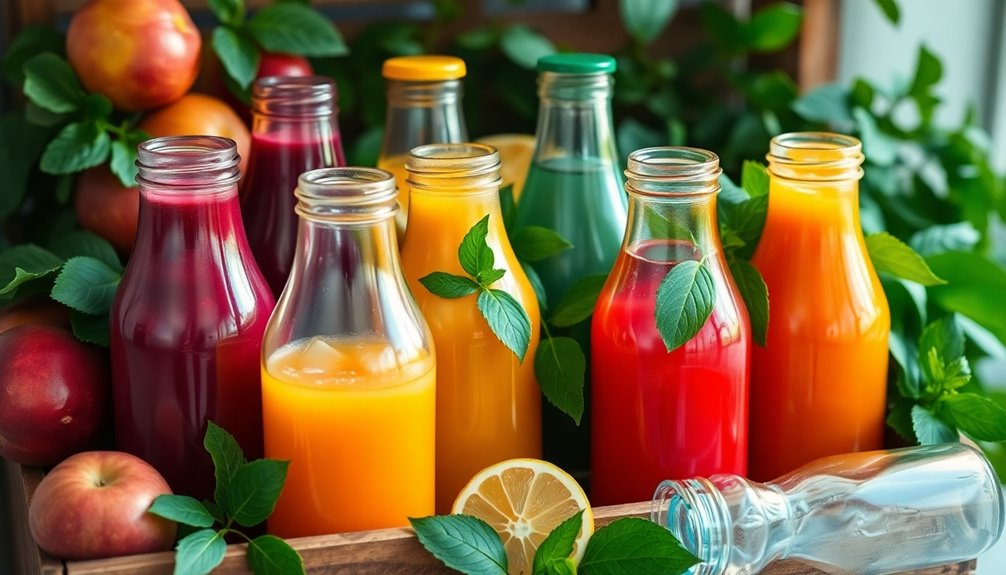
Plastic packaging may seem convenient, but it poses significant health risks that you should be aware of. Chemicals like BPA and phthalates can leach into your juice, leading to hormone disruption and increased cancer risks.
Microplastics, resulting from plastic degradation, infiltrate the food chain and pose dangers to human health. Long-term exposure to these chemicals has been linked to reproductive issues and developmental disorders in children.
Studies show that drinks in plastic containers expose you to higher levels of harmful substances compared to those in safer materials like glass. The World Health Organization has raised alarms about the cumulative effects of plastic chemical exposure, stressing the need for further research. Additionally, cold medications can also present health risks if not chosen carefully, as they may contain harmful additives and preservatives.
Choosing alternatives can safeguard your health and well-being.
Alternatives to Single-Use Plastics in Juice Packaging
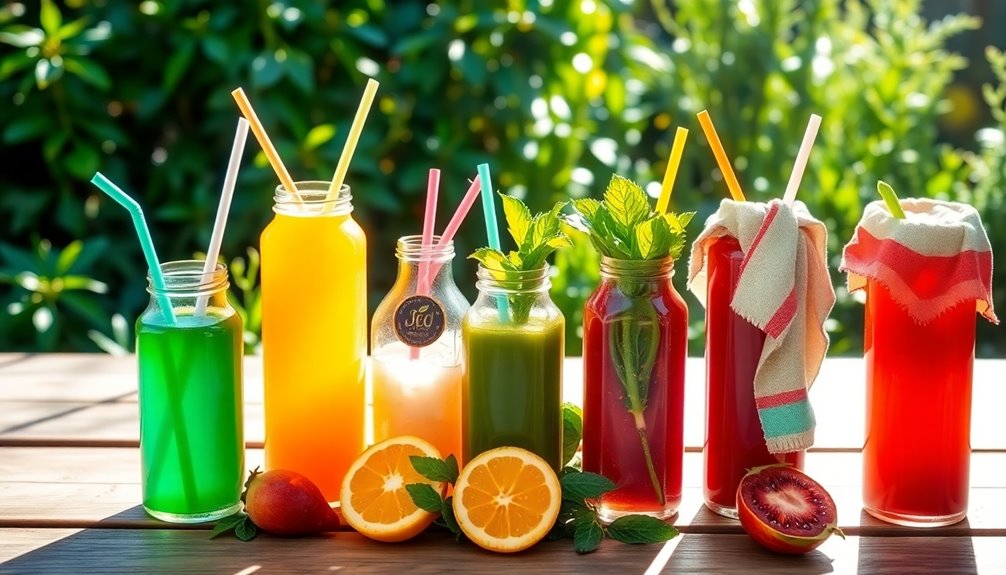
When you think about juice packaging, consider the exciting alternatives to single-use plastics that are making waves.
Sustainable materials like glass and plant-based options not only reduce waste but also enhance your juice experience.
Plus, innovative packaging solutions are evolving, offering you more choices to enjoy your favorite drinks while being kind to the planet.
Sustainable Packaging Materials
As consumers increasingly seek eco-friendly options, sustainable packaging materials are emerging as viable alternatives to single-use plastics in juice packaging.
Consider these four innovative solutions:
- Glass jars – Highly recyclable and can be reused indefinitely without losing quality.
- Plant-based materials – Made from renewable resources like cornstarch or sugarcane, offering biodegradable options that reduce environmental impact.
- Paperboard packaging – Lightweight, recyclable, and often derived from post-consumer waste, enhancing eco-credentials.
- Recyclable films – Innovations in compostable packaging promote a circular economy, like PepsiCo's bio-based bags that break down efficiently. This shift towards sustainable packaging aligns with the broader consumer demand for sustainable products in various industries, including tea.
Reusable Container Options
Considering the environmental impact of single-use plastics, many juice brands are turning to reusable container options that not only reduce waste but also enhance sustainability.
Reusable glass bottles serve as a sustainable alternative to plastic, maintaining material integrity while being highly recyclable.
Stainless steel containers keep your juice fresh and cold, boasting a lower carbon footprint due to their durability.
For those seeking biodegradable options, plant-based containers made from renewable resources like cornstarch or sugarcane effectively replace conventional packaging.
Refillable juice kegs exemplify how embracing a circular economy can cut down on waste.
Additionally, minimalist designs in reusable containers align with eco-friendly practices, appealing to environmentally conscious consumers while minimizing excess materials and waste. Incorporating reusable glass bottles into your juice storage can significantly reduce plastic waste.
Innovative Packaging Solutions
Innovative packaging solutions are transforming the juice industry, offering alternatives to single-use plastics that benefit both the environment and consumers.
Here are four sustainable options to evaluate:
- Biodegradable materials: Made from renewable sources like plant-based plastics derived from cornstarch or sugarcane.
- Glass bottles: Highly recyclable and can be reused multiple times without losing quality.
- Aluminum: Recycled indefinitely without degradation, greatly reducing the carbon footprint.
- Minimal packaging: Streamlined designs reduce waste and appeal to eco-conscious consumers.
Additionally, smart packaging technologies, such as QR codes for recycling info, promote environmental responsibility and sustainability awareness. Moreover, integrating energy monitoring features in packaging can help consumers track their environmental impact.
The Importance of Sustainable Packaging Solutions

Sustainable packaging solutions are essential for reducing waste and minimizing your impact on the environment.
By choosing eco-friendly materials like glass, aluminum, and biodegradable options, you're not only meeting consumer demand but also supporting a circular economy. Innovations in renewable energy technologies are pivotal for powering sustainable production processes, further enhancing the environmental benefits of using eco-friendly packaging.
Let's explore the benefits of these alternatives and how they can shape the future of juice packaging.
Benefits of Sustainable Packaging
As consumers become more eco-conscious, the benefits of sustainable packaging solutions are proving essential for both the environment and businesses.
Here are some key advantages you'll gain by opting for sustainable juice packaging:
- Reduce Waste: Minimize the environmental impact by cutting down on single-use materials.
- Lower Carbon Footprint: Utilize recycled materials to decrease energy consumption during manufacturing.
- Support a Circular Economy: Choose packaging designed for reuse, recycling, or biodegradation, keeping materials in circulation longer.
- Eco-Friendly Alternatives: Adopt plant-based packaging made from renewable resources to lessen reliance on traditional plastics.
- Additionally, using eco-friendly options can enhance your brand's reputation as consumers increasingly prioritize sustainable choices.
Types of Eco-Friendly Materials
When choosing eco-friendly juice packaging, you've got a range of materials that can make a significant difference in reducing your environmental impact. Here's a quick look at some sustainable options:
| Material | Benefits | Environmental Impact |
|---|---|---|
| Glass | Highly recyclable | Minimal long-term waste |
| Aluminum | Lightweight and recyclable | Lower carbon footprint |
| Bioplastics | Compostable alternatives | Reduces reliance on oil |
| Reusable Packaging | Encourages a circular economy | Minimizes single-use waste |
Additionally, opting for eco-friendly packaging not only supports sustainability but also promotes antioxidant-rich beverages that contribute positively to health. By choosing packaging materials that are biodegradable or recyclable, companies can reduce their environmental footprint while enhancing the appeal of their products. Consumers increasingly prefer brands that prioritize sustainability, making ecofriendly beverage packaging tips an essential consideration for businesses aiming to attract health-conscious customers. As a result, adopting these practices not only benefits the planet but also opens the door to a loyal customer base that values both quality and environmental responsibility.
Consumer Demand Trends
How essential is it for brands to align with consumer expectations for eco-friendly packaging? The rising consumer demand for sustainable packaging solutions is undeniable.
Here are four key trends driving this shift:
- Over 60% of consumers are willing to pay more for eco-friendly products.
- 72% expect brands to adopt biodegradable or recyclable materials.
- The beverage industry contributes 5% of global greenhouse gas emissions, urging brands to reduce their carbon footprint.
- Flexible packaging can minimize food waste while still being environmentally responsible. Furthermore, HEPA filtration technology in air purifiers serves as an example of how consumers are increasingly valuing products that enhance their health while also being eco-friendly.
Tips for Reducing Waste in Juice Storage
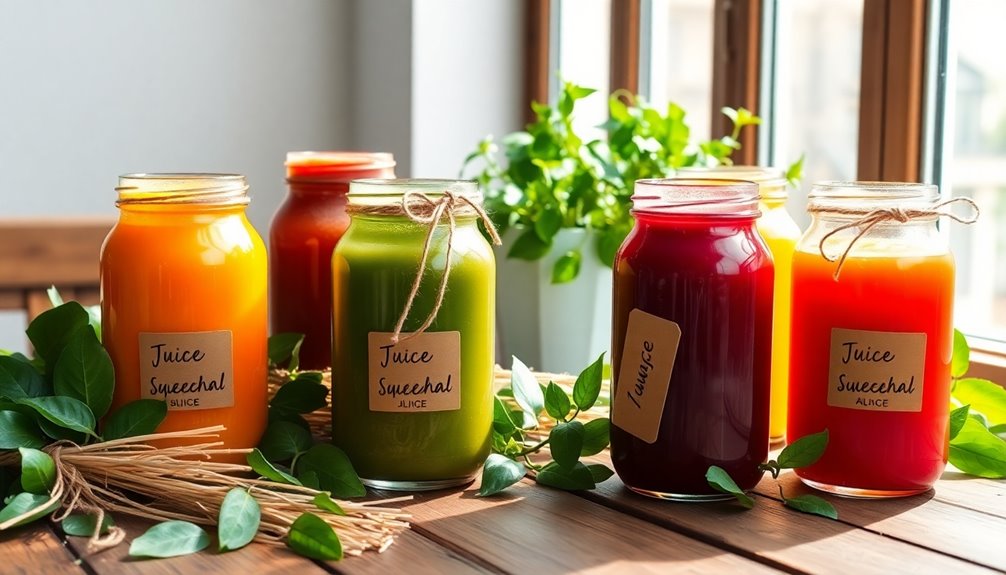
To effectively reduce waste in juice storage, start by opting for reusable glass or stainless steel containers. These reusable containers help maintain freshness without leaching harmful chemicals, markedly cutting down on single-use plastic waste.
Consider bulk buying juice from local sources that minimize packaging; this approach helps reduce waste from multiple smaller containers.
You can also implement DIY methods, like making homemade juice and using refillable bottles, to lessen reliance on store-bought options.
Educate yourself on recycling practices for juice containers, as proper recycling can close the loop and reduce landfill contributions.
Finally, explore biodegradable packaging options that break down faster than traditional plastics, ultimately lowering your environmental impact while enjoying your favorite juices.
Supporting Eco-Friendly Juice Brands and Practices

As you seek to make more sustainable choices in your beverage consumption, supporting eco-friendly juice brands is a powerful way to contribute to a healthier planet.
Here's how you can make a difference:
- Choose brands with sustainable packaging that uses biodegradable materials or recyclable plastics to reduce environmental impact.
- Opt for glass or aluminum containers; they support a circular economy as they're highly recyclable without losing quality.
- Support local juice producers to cut down on transportation emissions, while boosting your community's economy.
- Prioritize brands that align with consumer preferences for eco-friendly options, as nearly 50% of shoppers value sustainable practices.
Frequently Asked Questions
What Is the Most Environmentally Friendly Packaging for Liquids?
When considering the most environmentally friendly packaging for liquids, think about glass and aluminum.
Glass is endlessly recyclable and maintains its quality, while aluminum requires fewer resources to produce and is also highly recyclable.
You might want to explore paperboard options, which use recycled fibers and reduce waste.
Finally, look into plant-based materials for biodegradable alternatives, and consider reusable packaging to minimize single-use waste.
These choices greatly lessen your environmental impact.
How Is Eco-Friendly Packaging Sustainable?
Eco-friendly packaging is sustainable because it uses materials that minimize environmental impact.
When you choose biodegradable plastics or recycled paperboard, you're helping reduce landfill waste and conserve resources.
Glass and aluminum can be recycled indefinitely, promoting a closed-loop system.
Additionally, minimalist designs cut down on excess materials, reflecting a commitment to sustainability.
What Is the Best Eco-Friendly Packaging Options for Beverages?
Imagine holding a revitalizing drink in a container that's as kind to the planet as it's to your taste buds.
When looking for the best eco-friendly packaging options for beverages, consider glass, aluminum, and paperboard. Glass is endlessly recyclable, aluminum is energy-efficient, and paperboard boosts recycling efforts.
You can also opt for plant-based materials or reusable bottles, turning your drink into a sustainable choice that supports a healthier environment for everyone.
What Is the Most Environmentally Friendly Drink Container?
When you're choosing a drink container, glass stands out as one of the most environmentally friendly options.
It's endlessly recyclable without losing quality, so you can feel good about your choice.
Alternatively, aluminum cans are lightweight and also recyclable indefinitely, which helps reduce energy use.
If you're aiming for a more sustainable option, consider plant-based materials or reusable containers, as they greatly lower waste and promote a circular economy.
Conclusion
You might think eco-friendly juice packaging is expensive or hard to find, but that's simply not true! Many brands are now offering affordable, sustainable options that don't compromise on quality. By choosing these alternatives, you're not just enjoying your juice; you're making a positive impact on the planet. So, next time you grab a drink, consider reaching for something that's good for you and the environment. Together, we can sip sustainably and support a greener future!
Cindy thoroughly researches juicing trends, techniques, and recipes to provide readers with practical advice and inspiration. Her writing style is accessible, engaging, and designed to make complex concepts easy to understand. Cindy’s dedication to promoting the advantages of juicing shines through her work, empowering readers to make positive changes in their lives through the simple act of juicing.




